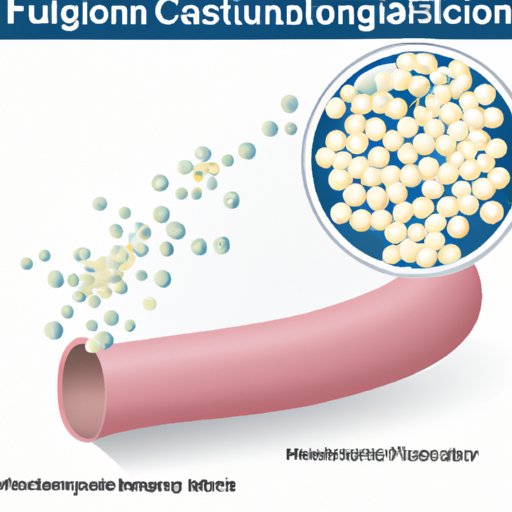Introduction
Fluconazole is an antifungal medication used to treat a variety of fungal infections, including yeast infections. It belongs to a class of medications known as azoles, which work by inhibiting the growth of fungi. This article will explore how fluconazole works, how it is used to treat fungal infections, its pharmacological properties, and potential side effects.

Exploring the Mechanism of Action of Fluconazole
Fluconazole works by disrupting the cell membrane of fungi, preventing them from growing and multiplying. It targets the enzyme cytochrome P-450, which is involved in the biosynthesis of ergosterol, an essential component of fungal cell membranes. As a result, the cell membrane becomes more permeable, allowing other molecules to enter the cell and disrupt its normal functioning.
In addition, fluconazole also affects other enzymes and proteins in the cell, leading to changes in gene expression and cell death. According to a study published in the journal Mycoses, “fluconazole inhibits the synthesis of ergosterol, resulting in a decrease in membrane fluidity and cellular permeability.” Thus, this drug can effectively inhibit the growth of pathogenic fungi.

Understanding How Fluconazole Treats Fungal Infections
Fluconazole is used to treat a variety of fungal infections, such as Candida albicans and Cryptococcus neoformans. It is also effective against other types of fungi, including Aspergillus fumigatus and Coccidioides immitis. The dosage and administration of fluconazole depend on the type of infection and the severity of symptoms.
Fluconazole is usually taken orally, but it can also be administered intravenously. The typical dose for adults is 50 to 400 mg per day, depending on the type and severity of the infection. For children, the dose is usually lower. It is important to take fluconazole for the full course of treatment prescribed by your doctor, even if the symptoms improve.
Investigating the Role of Fluconazole in Yeast Infection Treatment
Yeast infections are among the most common fungal infections treated with fluconazole. This drug is highly effective at killing the Candida albicans fungus, which is responsible for most yeast infections. However, there are other treatments that may be more effective in some cases.
For example, topical treatments such as creams or ointments may be more effective than oral medications. In addition, other antifungal medications, such as miconazole or clotrimazole, may also be recommended by your doctor. It is important to follow your doctor’s advice when treating a yeast infection.
Examining the Effectiveness of Fluconazole in Killing Pathogenic Fungi
Fluconazole is generally considered to be very effective in killing pathogenic fungi. A study published in the journal Antimicrobial Agents and Chemotherapy found that fluconazole was “highly active” against Candida albicans, Cryptococcus neoformans, and other species of fungi.
However, there are other antifungal medications that may be more effective in some cases. For example, amphotericin B is often used to treat severe fungal infections, while other drugs, such as itraconazole and terbinafine, may be more effective against certain types of fungi. Your doctor will be able to recommend the best treatment for your specific condition.

Analyzing the Pharmacological Properties of Fluconazole
Fluconazole has a half-life of about 30 hours, meaning that its effects last for up to two days. It is metabolized in the liver and excreted mainly in the urine. It does not accumulate in the body, so it does not need to be taken on a regular basis.
Investigating the Side Effects of Fluconazole
Fluconazole is generally well tolerated, but it can cause a range of side effects. Common side effects include nausea, vomiting, diarrhea, headache, dizziness, and rash. These tend to be mild and usually go away after a few days.
Rare side effects include liver problems, kidney problems, and low blood pressure. If you experience any of these symptoms, it is important to contact your doctor immediately. You should also contact your doctor if you experience any unusual or persistent side effects.
Comparing the Efficacy of Different Antifungal Drugs, Including Fluconazole
Fluconazole is generally considered to be safe and effective for the treatment of fungal infections. However, other antifungal drugs may be more effective in some cases. For example, amphotericin B is often used for severe fungal infections, while other drugs, such as itraconazole and terbinafine, may be more effective against certain types of fungi.
In addition, some antifungal medications, such as miconazole and clotrimazole, may be more effective than fluconazole for the treatment of yeast infections. It is important to talk to your doctor before starting any antifungal medication.
Conclusion
Fluconazole is an effective antifungal medication used to treat a variety of fungal infections. It works by inhibiting the growth of fungi, preventing them from multiplying and causing infection. It is typically taken orally, but can also be administered intravenously. Fluconazole is generally safe and well tolerated, but can cause a range of side effects. It is important to talk to your doctor before starting any antifungal medication.
(Note: Is this article not meeting your expectations? Do you have knowledge or insights to share? Unlock new opportunities and expand your reach by joining our authors team. Click Registration to join us and share your expertise with our readers.)
